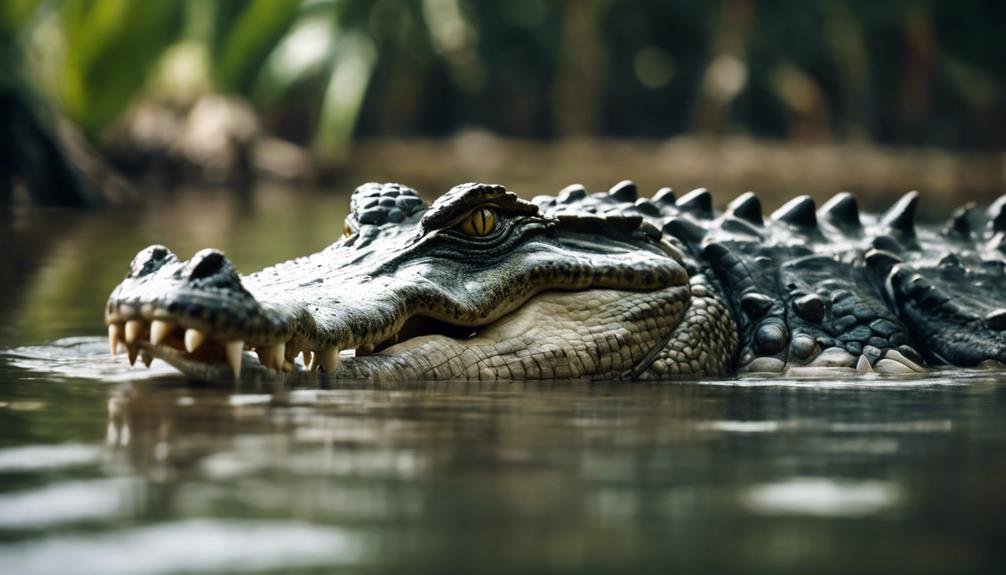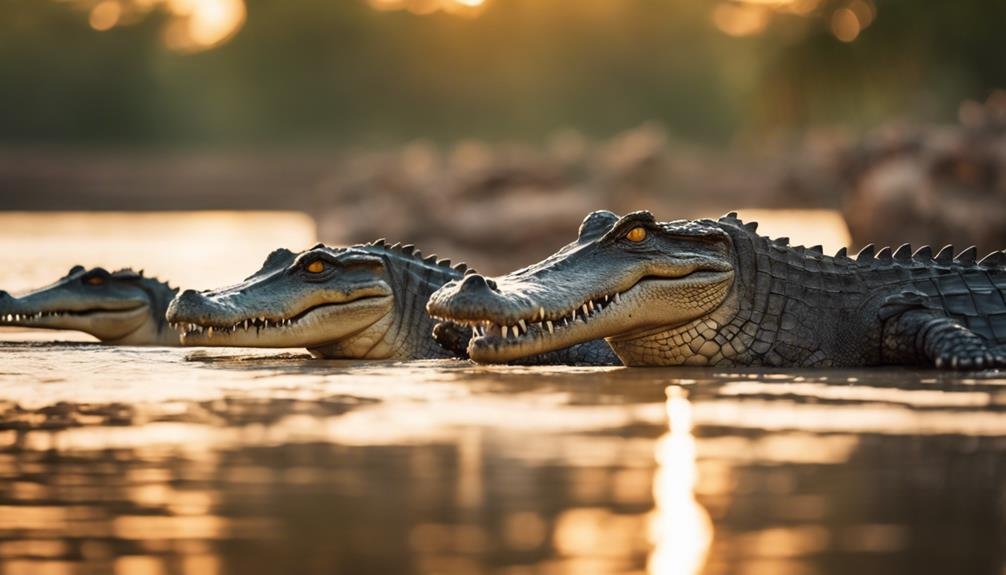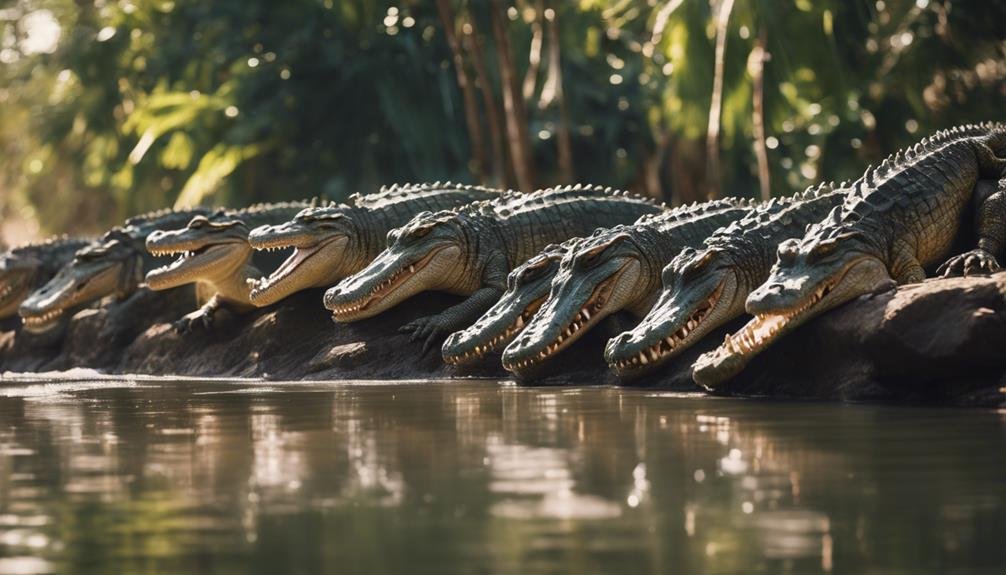You might find it intriguing to learn that a group of crocodiles is called a bask. Basking is more than just a collective term; it’s an essential strategy for these reptiles, providing numerous benefits from safety in numbers to improved hunting efficiency. While you’re aware that crocodiles can be formidable solitary predators, have you considered how their behavior shifts within the dynamics of a bask? Each crocodile plays a role that’s important to the group’s success, which might lead you to wonder how these roles are distributed and what impact they have on the survival of the species. Let’s explore how these ancient creatures interact in their communities, shedding light on the complexities of their social structures.
Key Takeaways
- A group of crocodiles is called a “bask.”
- Basks consist of crocodiles engaging in both hunting and resting together.
- Living in a bask increases survival by enhancing protection and resource sharing.
- Basking helps crocodiles regulate their body temperature efficiently.
- Social structures within basks can include roles like protection of offspring and territorial dominance.
Understanding Collective Nouns
While exploring the animal kingdom, you’ll find that collective nouns offer a unique way to describe groups of animals, reflecting their behaviors and characteristics. For example, a group of crocodiles is called a bask. This term isn’t just a label; it’s a window into understanding the social and environmental interactions of these reptiles.
Delving into collective nouns, you’ll learn that they’re not arbitrary. They’re crafted from observations and insights into the lives of animals. Knowing that crocodiles bask together highlights their behavior, particularly how they often rest in the sun on riverbanks. This isn’t just trivia; it’s a piece of the puzzle in understanding crocodile ecology and behavior.
Moreover, these terms enrich your language, allowing you to communicate more effectively and vividly about wildlife. When you say ‘a bask of crocodiles,’ it evokes a specific image and context, enhancing both scientific discussions and casual conversations about these creatures.
Characteristics of a Crocodile Bask
You’ll notice that crocodiles in a bask strategically alternate between hunting and resting, which helps them conserve energy effectively. By living in a group, these remarkable reptiles enhance their survival rates, especially for the vulnerable young ones who benefit greatly from the added protection against predators. Basking in the sun is not just a leisure activity; it’s a critical process for thermoregulation, and doing this as a group maximizes their exposure to essential sunlight while maintaining safety in numbers.
Female crocodiles within the bask exhibit intense protectiveness towards their nests and offspring, ensuring that the future of their bask remains secure. Here’s a snapshot of how a crocodile bask operates:
| Behavior | Benefit |
|---|---|
| Alternating hunting | Energy conservation |
| Resting in groups | Safety and thermoregulation |
| Basking in the sun | Efficient use of sunlight |
| Protection of young | Safety from predators |
| Nest protection | Offspring survival |
This organized structure not only facilitates effective resource sharing among the crocodiles but also fortifies the group, making each member’s survival more likely in the challenging wild.
Variations Across Different Species


Exploring the social structures of different crocodile species reveals fascinating variations in their group behaviors. You’ll find that the way these reptiles interact and organize themselves can be quite different from one species to another, much like how a group of kangaroos has its own unique social hierarchy.
For instance, Nile crocodiles typically form a group dominated by a single male who controls access to multiple females. This structure is somewhat akin to other animal societies where there’s a clear hierarchy and social order.
On the other hand, saltwater crocodiles display more flexible group dynamics. Their groups might change in composition depending on the availability of resources such as food and territory. This adaptability in forming groups is essential for survival, especially in environments where resources are inconsistent.
These variations among species aren’t just interesting tidbits; they’re vital for understanding how these animals survive in their respective habitats. Each group of animals, though closely related, adapts to its environment in uniquely effective ways. By studying these differences, you gain insights into not just their social interactions but also broader ecological and conservation issues.
Social Behavior in Crocodiles
Building on these insights into group dynamics, let’s examine the specific social behaviors that govern how crocodiles interact within their basks. You’ll find it fascinating how these reptiles, known for their solitary and aggressive reputation, actually live in groups called basks. This social structure allows them to take turns hunting and resting, which is essential for survival in the wild.
Living in groups isn’t just about convenience; it’s a strategic move. Group cooperation is essential, especially when it comes to protecting the young from predators. Imagine being part of a team where everyone has a role, ensuring the safety and survival of the group’s future generations.
In a bask, you might see up to 20-30 crocodiles, sharing space and resources. This is particularly true for larger species like the Nile crocodile, where typically one male dominates several females. Such a setup helps in conserving energy and efficiently utilizing the available resources.
Here’s a fun fact: the social structure within these groups can be quite complex, with specific roles and hierarchies that maintain smooth functioning and minimal conflict. Isn’t it intriguing how these fierce creatures manage their social lives?
Is a Group of Alligators Similar to a Group of Crocodiles?
Yes, there is a difference between alligators and crocodiles. Both are members of the reptilian order Crocodylia, but alligators are found in freshwater environments in the southeastern United States and China, while crocodiles are found in a wide variety of tropical and subtropical habitats in Africa, Asia, the Americas, and Australia.
Importance of Group Living


Living in groups offers crocodiles essential safety benefits, particularly through protection against predators. When you’re part of a croc crowd, you’re banking on safety in numbers. It’s not just about being vigilant; it’s about multiple eyes, ready to spot danger long before it gets too close. This communal vigilance allows each crocodile to relax a bit more, conserving energy for when it truly counts.
These reptilian gatherings aren’t just about staying safe; they’re also about securing a meal. Cooperation within the group means you can tackle bigger, more nutritious prey. Imagine a band of crocodiles coordinating an attack on a large water buffalo—it’s teamwork in its most primal form.
But let’s not forget the little ones. Offspring protection is paramount, and female crocodiles in a group vigilantly guard their nests. This collective effort guarantees more young survive their most vulnerable phase.
- Visualize a group of crocodiles, submerged just beneath the water’s surface, eyes just above the line, watching… waiting.
- Picture a synchronized surge of powerful bodies, working as one to corner a formidable prey.
- Imagine a sun-drenched riverbank, dotted with nests guarded by watchful mothers, their presence a deterrent to any predator.
In the world of crocodiles, group living isn’t just a lifestyle; it’s a survival strategy.
Conclusion
You’ve learned that a group of crocodiles is called a bask. This social structure isn’t just about living together; it’s essential for their survival.
In a bask, crocodiles benefit from protection, efficient hunting, and energy conservation through their roles and hierarchies. Whether it’s the dominant Nile crocodiles or other species, understanding the dynamics of a crocodile bask highlights the importance of group living in the wild.
Remember, there’s strength in numbers, even for crocodiles.


